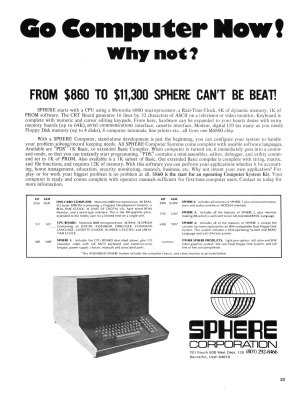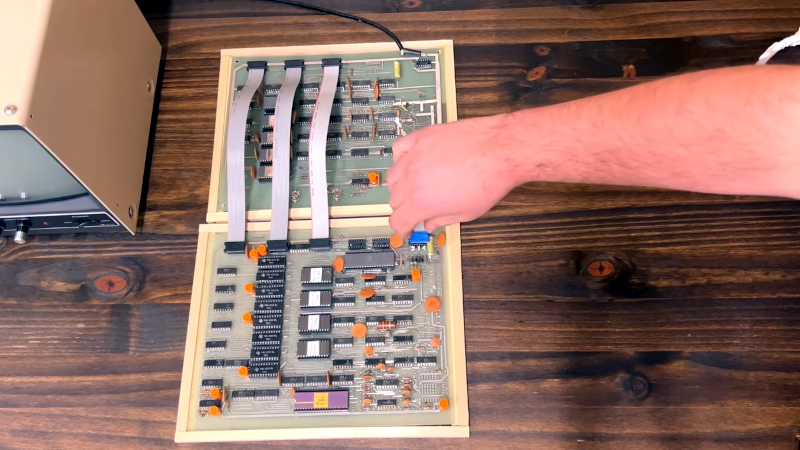[Ben Z] loves the Sphere computer, a very early entry in the personal computer boom of the mid 1970s. The 6800 CPU was unique in its day that it was a full system — at least in theory. If you could afford the whole system, you got a nice case with a keyboard and a memory-mapped display board. You can see a great video tour of the system below the break.
The Sphere suffered from a few problems, none of which were easily foreseeable by its designer. First, the 6800 didn’t get the traction that the 8080-derived CPUs did. Second, the S-100 bus would prove to be popular but that nearly always meant an 8080-type processor in practice. Third, while an all-in-one system was the right idea, it was pricey at the time, and many people would opt for something less expensive even if it had less capability. People also wanted to leverage hardware they may have already had. It was easier to imagine hooking up a surplus TeleType, for example, to a more conventional computer than to a Sphere that expected its own display hardware and keyboard.
 A CPU board for the Sphere was $522 in kit form; the entire computer was $860 or $1,400 if you wanted it assembled. If you wanted a modem and cassette interface, you’d spend about $100 more. For $2,250 you could get assembled computer with 20K of memory along with the modem/cassette. A floppy disk and printer system cost $8,000 and, for some reason, the company’s ads mentioned you could spend up $11,300, but it doesn’t say for what.
A CPU board for the Sphere was $522 in kit form; the entire computer was $860 or $1,400 if you wanted it assembled. If you wanted a modem and cassette interface, you’d spend about $100 more. For $2,250 you could get assembled computer with 20K of memory along with the modem/cassette. A floppy disk and printer system cost $8,000 and, for some reason, the company’s ads mentioned you could spend up $11,300, but it doesn’t say for what.
Unlike many similar computers that used a card edge connector, the Sphere used ribbon cables to connect boards. According to the video, this was a common point of failure for the Sphere. The mini assembler was quite strange, doubtlessly so it would fit in the cramped ROM. It used hex codes but was able to manage labels and addresses to make writing machine code a bit easier.
The computer was more or less contemporary with the SOL 20, another somewhat similar all-in-one. While the Sphere was a bit earlier, it was done by 1977. The SOL 20 appeared shortly thereafter but continued until 1979. The 12,000 SOL-20s sold dwarf the Sphere’s sales which might have been around 1,300 units. However, the IBM PC would appear and wipe out all these machines. If you want to see more about the Sphere, there’s an hour video from the Vintage Computer Federation featuring [Ben Z] talking about the computer. You can watch that video, below.
Everyone “knew” the workstation was coming, but we didn’t know exactly how. While the SOL-20 might have been a few months behind the Sphere, there were earlier commercial all-in-one machines like the MCM/70 that cost nearly $10,000 and the IBM 5100 ($9,000).
















I just came across the videos the other day and until then I had not known about the Sphere system. I cut my teeth on the IMSAI-8080 back in the 70’s and would have liked to have had a chance to work with a Sphere as well had I known about it.
This things reminds me more of a microcontroller system or a in-circuit development system than a personal computer.
It doesn’t seem to offer a bus connector, for example.
Something the Apple II or IBM PC were popular for.
Some sort of USER port seems also missing.
To me, that looks more of an educational toy, like Sharp MZ-40K, those MC14500B 1-Bit computers, the KIM-1, the COSMAC VIP, CHIP-8, etc. Still fun to tinker with.
Maybe the “computer” can be used to drive a little robot, like HERO-1.
On the other hand.. The HERO 2000 already had a sophisticated MS-DOS computer with a floppy drive..
The bus are those ribbon cables that go between the boards in the video. A normal full Sphere would have the same ribbons, but with multiple headers per cable, connecting a system of four or five boards. Yes, really bad design!
Exactly. (OP of the video here.) The challenges with the ribbon bus design may not be as evident in this video but once you had 4+ boards (as would be typical) the cables would sort of loop in and out across the card cage, and any jostling at all would risk some plugs wiggling out pin by pin, and it would be so hard to track down those failures. Additionally, the bus was not terminated on the cables or boards, so depending on exactly how you set it up, you might get “ringing” of the signals causing interference– also super hard to track down. AND the power rails were running through very small gauge wires and the path to ground was constricted and noisy.
Many Sphere users ended up hand-modifying the boards to string additional ground lines across, or add terminators, or literally tape or clamp the cables into place.
The “mini assembler” looks like an ordinary “monitor program” to me. The Sharp MZ-80K and its sister models from the late 70s had such a thing, too.
I preferred the 6800 architecture to the more complicated 8080. My first job was on a team that designed a 6802-based display terminal. The 6802 was a 6800 with an internal oscillator, something the 6800 didn’t have (it required an external crystal oscillator chip).
The 6800 was very “DEC-like”, in that it had a flat address space and memory-mapped IO. It lacked the ability to do arithmetic on the index register (only increment/decrement by 1), a fault which was remedied in the 6809. Still, the 6800 has always been my favourite.
It was fixed to a limited extent in the 6801, which had ABX (and also the ability to push and pop X from the stack, which the 6800 unaccountably lacked), but by then the die had been cast.
I had forgotten the 6801.
“However, the IBM PC would appear and wipe out all these machines”
Huh? What a silly statement in reference to these mid ‘70s small market machines. There were multiple entire generations of extremely successful computers between the Trinity of 77 (Apple II, TRS-80, and PET) and the eventual dominance of the PC. How soon the young people forget. Saying the PC ended computers like the Sol and Sphere is hilariously wrong.
“Hilariously wrong” was exactly what I was thinking.
Yup. I had my TRS-80 Model 1 for a number of years, before I built my 1st IBM compatible PC.
Sure it didn’t happen overnight. I had a quasar QDP 100 long after they were PCs and a TRS-80 model 3. But all these non-IBM compatible machines except for the Mac or doomed whether they died off early or whether they died off a little bit later. Bill
I think that the retro computing thing is more than just history. All the little computers than Microsoft stomped–are coming back.
I think you mean “IBM stomped” if anything. Microsoft wrote the software (mainly BASIC) for many of these “retro” systems.
I think I had an early model. I mounted the boards in a Smith Corona typewriter case. Used a stereo tape for storage and a Sony b/w TV as a monitor.
Hey Cal– this is Ben Z (OP of the video). If you used a Sphere back in the 70s, would you be able to get in touch with me? I’d like to speak with you about the typewriter case and your story with the machine. (Email addr at bzotto at gmail, or contact via website link above.) Thanks!
I was Sphere’s very first order and I also won their first annual “What do you use your Sphere computer for” contest. I designed a pixel graphics board and hand controllers for the spere and wrote a two player tank war game. My unit was bought by a collector sometime around 1976 and I hope it is still around.
🤘
2023 we have gcc c compiler capable of converting transparent portable c code into x86, arm A and M series, risc-v machine binaries.
And inexpensive sbcs to test our codes.
c/c++ industries attempted to convince the world starting ~1991 ~” if it is not programmed in c/c++ it is no good …. and must be replaced”?
Bugs and malware frequent updates are debunking the ctards claims.
Plus all of version too.
And the software maintenance coss. :(
Time to counterattack with simple systems only containing code used the the embedded controller app?
NSA software guideline insisted on this in the 1980s.
Ctards changed the rules?
In 1970s commercial BASICs 1 Wang 2200 2 IBM 5100 3 HP 9800.
These compared to ‘hobby’ software technologies presented here.
And Microsoft BASIC too, of couse.
All impressive contributions to computing, imo.
Intel MSC BASIC-52 is a port of above 3 commercial BASICs to the 8051 family, imo.
A WOW ++?
Author who spent year off from Intel in Chandler AZ to write.
On return to Intel MCS BAIC-52 writer promoted to Intel VP, Intel deceased engineer reported.
We hope you readers see ‘the light’ with help of gcc c transparent portable machine binary code.
Ports to ARM Cortex A and M series and risc-v. ?
Qualcomm SM6225 Snapdragon 680?
Albert Gore willing, of couse.
I have been trying to find a find a Sphere Computer. Any offer welcome. If you have one to offer, please visit my website http://www.TheApple-1.com (click on Contact) and email me.